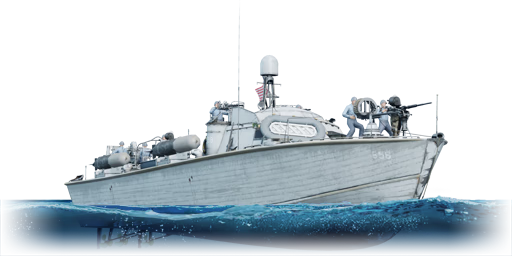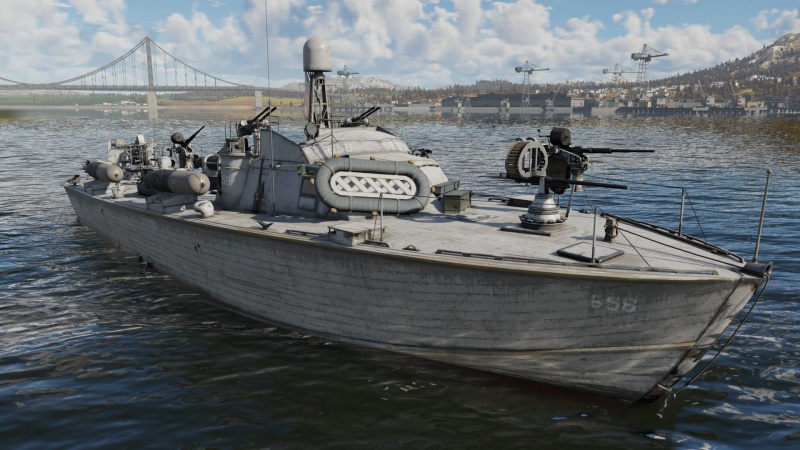Difference between revisions of "PT-658"
m (Fixed spacing error) (Tag: Visual edit) |
|||
| Line 12: | Line 12: | ||
{{Specs-Fleet-Armour}} | {{Specs-Fleet-Armour}} | ||
<!-- ''Talk about the vehicle's armour. Note the most well-defended and most vulnerable zones, e.g. the ammo magazine. Evaluate the composition of components and assemblies responsible for movement and manoeuvrability. Evaluate the survivability of the primary and secondary armaments separately. Don't forget to mention the size of the crew, which plays an important role in fleet mechanics. Save tips on preserving survivability for the "Usage in battles" section. If necessary, use a graphical template to show the most well-protected or most vulnerable points in the armour.'' --> | <!-- ''Talk about the vehicle's armour. Note the most well-defended and most vulnerable zones, e.g. the ammo magazine. Evaluate the composition of components and assemblies responsible for movement and manoeuvrability. Evaluate the survivability of the primary and secondary armaments separately. Don't forget to mention the size of the crew, which plays an important role in fleet mechanics. Save tips on preserving survivability for the "Usage in battles" section. If necessary, use a graphical template to show the most well-protected or most vulnerable points in the armour.'' --> | ||
| − | The survivability of the PT-658 is the same as most other small coastal vessels | + | The survivability of the PT-658 is the same as most other small coastal vessels: if you get hit, it's going to hurt. The wooden construction and lack of dedicated armour on the boat makes for a short lifespan while under fire if not approached carefully. The best way to maximize your odds is hide behind islands, outcroppings, or other form of cover until an unaware victim has passed. Captains should also remember that large calibre shells may destroy the vessel outright with a single direct hit, making even the weakest destroyer a valid threat. |
| − | Ammunition on the PT-658 is stored in two locations; one cache below the forward | + | Ammunition on the PT-658 is stored in two locations; one cache below the forward 37 mm cannon and the other below the 40 mm cannon. This often means that when an opponent is aiming to knock out your two main armaments they may detonate your ammo. |
=== Mobility === | === Mobility === | ||
{{Specs-Fleet-Mobility}} | {{Specs-Fleet-Mobility}} | ||
<!-- ''Write about the ship's mobility. Evaluate its power and manoeuvrability, rudder rerouting speed, stopping speed at full tilt, with its maximum forward and reverse speed.'' --> | <!-- ''Write about the ship's mobility. Evaluate its power and manoeuvrability, rudder rerouting speed, stopping speed at full tilt, with its maximum forward and reverse speed.'' --> | ||
| − | PT boats in general have excellent mobility, and the PT-658 is no exception to this rule. It combines superb acceleration, excellent | + | PT boats in general have excellent mobility, and the PT-658 is no exception to this rule. It combines superb acceleration, excellent manoeuvrability in tight spaces, and an above average top speed to make for an excellent early game capture point taker. |
{{NavalMobility}} | {{NavalMobility}} | ||
Revision as of 07:06, 27 November 2022
Contents
Description
The Higgins 78 ft PT-658 is a premium gift rank American motor torpedo boat with a battle rating of (AB), (RB), and (SB). It was introduced during Update "Direct Hit" as a reward for Battle Pass: Season V, "River Hunter".
General info
Survivability and armour
The survivability of the PT-658 is the same as most other small coastal vessels: if you get hit, it's going to hurt. The wooden construction and lack of dedicated armour on the boat makes for a short lifespan while under fire if not approached carefully. The best way to maximize your odds is hide behind islands, outcroppings, or other form of cover until an unaware victim has passed. Captains should also remember that large calibre shells may destroy the vessel outright with a single direct hit, making even the weakest destroyer a valid threat.
Ammunition on the PT-658 is stored in two locations; one cache below the forward 37 mm cannon and the other below the 40 mm cannon. This often means that when an opponent is aiming to knock out your two main armaments they may detonate your ammo.
Mobility
PT boats in general have excellent mobility, and the PT-658 is no exception to this rule. It combines superb acceleration, excellent manoeuvrability in tight spaces, and an above average top speed to make for an excellent early game capture point taker.
| Mobility Characteristics | |||
|---|---|---|---|
| Game Mode | Upgrade Status | Maximum Speed (km/h) | |
| Forward | Reverse | ||
| AB | |||
| Upgraded | |||
| RB/SB | |||
| Upgraded | |||
Modifications and economy
Armament
Primary armament
Provide information about the characteristics of the primary armament. Evaluate their efficacy in battle based on their reload speed, ballistics and the capacity of their shells. Add a link to the main article about the weapon: {{main|Weapon name (calibre)}}. Broadly describe the ammunition available for the primary armament, and provide recommendations on how to use it and which ammunition to choose.
Secondary armament
Some ships are fitted with weapons of various calibres. Secondary armaments are defined as weapons chosen with the control Select secondary weapon. Evaluate the secondary armaments and give advice on how to use them. Describe the ammunition available for the secondary armament. Provide recommendations on how to use them and which ammunition to choose. Remember that any anti-air armament, even heavy calibre weapons, belong in the next section. If there is no secondary armament, remove this section.
Anti-aircraft armament
An important part of the ship's armament responsible for air defence. Anti-aircraft armament is defined by the weapon chosen with the control Select anti-aircraft weapons. Talk about the ship's anti-air cannons and machine guns, the number of guns and their positions, their effective range, and about their overall effectiveness – including against surface targets. If there are no anti-aircraft armaments, remove this section.
Additional armament
Describe the available additional armaments of the ship: depth charges, mines, torpedoes. Talk about their positions, available ammunition and launch features such as dead zones of torpedoes. If there is no additional armament, remove this section.
Usage in battles
Describe the technique of using this ship, the characteristics of her use in a team and tips on strategy. Abstain from writing an entire guide – don't try to provide a single point of view, but give the reader food for thought. Talk about the most dangerous opponents for this vehicle and provide recommendations on fighting them. If necessary, note the specifics of playing with this vehicle in various modes (AB, RB, SB).
Pros and cons
Summarise and briefly evaluate the vehicle in terms of its characteristics and combat effectiveness. Mark its pros and cons in the bulleted list. Try not to use more than 6 points for each of the characteristics. Avoid using categorical definitions such as "bad", "good" and the like - use substitutions with softer forms such as "inadequate" and "effective".
Pros:
Cons:
History
Describe the history of the creation and combat usage of the ship in more detail than in the introduction. If the historical reference turns out to be too long, take it to a separate article, taking a link to the article about the ship and adding a block "/History" (example: https://wiki.warthunder.com/(Ship-name)/History) and add a link to it here using the main template. Be sure to reference text and sources by using <ref></ref>, as well as adding them at the end of the article with <references />. This section may also include the ship's dev blog entry (if applicable) and the in-game encyclopedia description (under === In-game description ===, also if applicable).
Media
Excellent additions to the article would be video guides, screenshots from the game, and photos.
See also
Links to articles on the War Thunder Wiki that you think will be useful for the reader, for example:
- reference to the series of the ship;
- links to approximate analogues of other nations and research trees.
External links
| Higgins Industries Ships | |
|---|---|
| Patrol Torpedo Boats (PT) | |
| 81' PT Prototype | PT-6 |
| 78' PT | PT-71 · PT-200 · PT-658 · MTB-422* · MS 444** |
| *PT-92 in UK service | |
| **PT-94 in Italian service | |
| USA boats | |
|---|---|
| Motor torpedo boats | PT-3 · PT-6 · PT-20 · PT-71 · PT-103 · PT-109 · PT-174 |
| PT-200 · PT-314 · Thunderbolt (PT-556) · PT-565 · PT-658 · PT-810 · PT-811 · PT-812 | |
| Motor gun boats | Kim Qui · LCS(L)(3) · PT-59 · PTF-7 · USS Candid · USS Asheville · USS Douglas · USS Flagstaff · USS Tucumcari · USS Cyclone |
| Armoured gun boats | LCM(6) Zippo |
| USA premium ships | |
|---|---|
| Motor torpedo boats | PT-3 · PT-109 · PT-174 · Thunderbolt (PT-556) · PT-658 · PT-811 |
| Motor gun boats | LCM(6) Zippo · USS Douglas · USS Flagstaff |
| Sub-chasers | Carmi (PC-466) |
| Destroyers | USS Welborn C. Wood · USS Wilkinson · USS Bennion · USS Cowell · USS Davis · USS Moffett · USS Phelps · USS Frank Knox |
| Light cruisers | USS Detroit · USS Helena |
| Heavy cruisers | USS Des Moines |
| Battleships | USS Arkansas |





